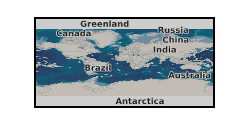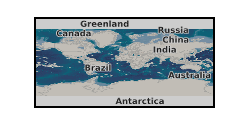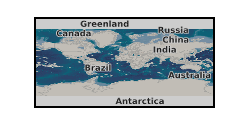Lead isotopes
Type of resources
Topics
Keywords
Contact for the resource
Provided by
Years
Formats
Update frequencies
-

The excel table presents the high-resolution LA-MC-ICP-MS Pb isotope data (± 2S%) produced for the Paleocene interval of Fe-Mn crust core sample 085_004 recovered in 2016 during the JC142 expedition to Tropic Seamount for the MarineE-Tech project. A detailed description of the sample can be found in Josso et al., 2019 and 2020. The Scripts data are Matlab and R readable file presenting all scripts and built-in functions used during the processing of the data to demonstrate the presence of astronomical imprint on the cyclicity of the Pb isotope ratios.
-

The file contains the LA-MC-ICP-MS composite Pb isotope ratios for Tropic Seamount, north-east Atlantic Ocean, spanning a deposition history covering the last 75 Ma. The record was obtained by analysis of hydrogenetic ferromanganese crust samples recovered during the 2016 JC142 expedition of the MarineE-Tech project.
-

The dataset contains three subsets: 1) W isotope data for reference materials and geological samples, 2) Pb isotope data for reference materials and geological samples and 3) Mo isotope data for reference materials and geological samples. The data was collected over a period of about two years in two different laboratories (University of Manchester and University of Bristol) using multi-collector ICPMS techniques. A description of the methods used to obtain the W and Mo isotope data can be found in Willbold et al. (2011) and Willbold et al. (2016). The determination of the Pb isotope data is detailed in Freymuth et al. (2016). The data of reference materials (standard solutions and geological reference materials) is used to assess the reproducibility and accuracy of the mass spectrometric setup at the time and used as uncertainty estimate for the geological sample data. References: Freymuth, H., Elliott, T., van Soest, M., Skora, S., 2016. Tracing subducted black shales in the Lesser Antilles arc using molybdenum isotope ratios. Geology 44, 987-990. Willbold, M., Elliott, T., Moorbath, S., 2011. The tungsten isotopic composition of the Earth's mantle before the terminal bombardment. Nature 477, 195-198. Willbold, M., Hibbert, K., Lai, Y.-J., Freymuth, H., Hin, R.C., Coath, C., Vils, F., Elliott, T., 2016. High-Precision Mass-Dependent Molybdenum Isotope Variations in Magmatic Rocks Determined by Double-Spike MC-ICP-MS. Geostandards and Geoanalytical Research 40, 389-403.
-

The file contains the validation data on certified reference material for Nd isotope measurement, the LA-MC-ICP-MS composite Pb isotope ratios and Nd isotope time series for Tropic Seamount, north-east Atlantic Ocean. The dataset spans a deposition history covering the last 75 Ma. The record was obtained by analysis of hydrogenetic ferromanganese crust samples recovered during the 2016 JC142 expedition of the MarineE-Tech project.
-

We provide here Pb isotope data for the basement rocks cored during IODP Expedition 352 (Bonin Forearc). The data are reported as 206Pb/204Pb, 207Pb/204Pb and 208Pb/204Pb ratios together with their errors. The overall accuracy of the data was determined using international standard NBS SRM 981. Values for this standard achieved during the measurement period were 206Pb/204Pb = 16.9404 ±32,207Pb/204Pb = 15.4969 ±32, 208Pb/204Pb = 36.7149 ±90 (2sd; n=44). The data are separated into four parts one for each drill site that cored basement. Sites 1440B and 1441A both sampled a basalt type known as FAB (Forearc Basalts), whereas Sites 1439C and 1442A both sampled boninites (Mg-rich andesites). Both rock types are typical of the forearc setting and contain information needed to understand the process of subduction initiation. A summary of the Expedition, and hence the petrography and setting of the samples as well as the various scientific objectives for the project to which these analyses contribute) may be found in: Reagan, M.K., Pearce, J.A., and Petronotis, K., Expedition Scientists, 2015, Izu-Bonin-Mariana Fore Arc: Proceedings of the International Ocean Discovery Program, 352. International Ocean Discovery Program, http://dx.doi.org/10.14379/iodp.proc.352.2015.
-

U-Pb isotope ratio data set for numerous phosphate (apatite) grains in two thin section samples of the LL5 S4-6 Chelyabinsk meteorite. One section is of the S4-6 light lithology, and another of the S5-6 dark lithology. Samples analysed were section ‘A' (light lithology) and section ‘B’ (dark lithology) of Chelyabinsk, both from the Open University School of Physical Sciences sample collection. The results demonstrate variability in degree of Pb-loss during collisional reheating from pristine versus damaged apatite crystal domains. These results are reported for a meteorite fall which originally happened near Chelyabinsk in Russia. The results otherwise have no geographic location, as this is a sample of an asteroid. All measurements were made in December 2020. These data were collected using Secondary Ionisation Mass Spectrometry (SIMS) with a CAMECA IMS 1280 at the Institute of Geology and Geophysics, Chinese Academy of Sciences (IGGCAS). The thin sections were polished with colloidal silica, cleaned, and coated with gold prior to analysis. Microtextural information was obtained prior to analysis using a combination of back-scatter-electron, cathodoluminescence, and electron-back-scatter-diffraction analysis. Data were obtained to test hypotheses relating to the competition between macro-to-meso-scale thermally-driven variation in Pb-loss rates versus microscale variation driven by grain-specific features, e.g., fracture networks. An article describing and discussing these results, including further methodological steps in their collection and processing, is due for publication. This information is currently available in preprint form on arXiv: https://arxiv.org/abs/2112.06038
 NERC Data Catalogue Service
NERC Data Catalogue Service